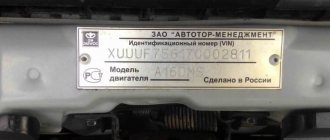Seizure of property, for example, a car, which includes a ban on registration actions, is a measure to ensure the execution of a court decision by negligent debtors. For example, the debtor refuses to repay the debt - alimony, loans, taxes, fines.
But as soon as the bailiff begins to seal and confiscate his car, the money is immediately found.
Another situation also happens: the debtor understands that any day now a bailiff will come to his garage and take his “swallow” to be torn to pieces by evil creditors. And the creditors are his ex-wife and children. And then, with tears in his eyes, he decides to get rid of such property in order to leave his “bloody little ones” with their noses.
If you think that this topic concerns exclusively malicious non-payers of alimony and taxes and other scoundrels, then we will inform you - we have bad news for you.
As it was said in the classics of Soviet cinema: “Everyone who doesn’t have a car dreams of buying one, and everyone who has a car dreams of selling it. And he doesn’t do this only because if you sell, you’ll be left without a car. Man, more than any other living creature, loves to create additional difficulties for himself.”
Reasons for car seizure?
Let's look at the most common reasons why property may be seized and why restrictions may be placed on it.
- If the owner of the car owes more than 3,000 rubles in enforcement proceedings;
- The presence in court of a civil case regarding the division of jointly acquired property of the spouses, which is a car. Or cases under a loan agreement, where the collateral is a car;
- Consideration by an arbitration court of a bankruptcy case of a potential seller;
- Initiation of a criminal case by law enforcement agencies, in which the vehicle was seized.
What are the risks of buying a seized car?
FSSP website
In such a situation, you will need to contact the documented owner of the car to remove legal restrictions or to return the money paid for the purchase of the car. In some cases, the process of returning money is formalized through the court.
However, this method may also be ineffective due to the defendant’s lack of income and property, as a result of which the court may find it impossible to pay the cost of the car.
- Calculation of financial obligations. The method is relevant only if the amount payable is less than the cost of the vehicle. If a car purchased under a power of attorney is seized, it is necessary to decide on paying off debts and lifting the seizure from the car with its owner.
- By appealing the decision in the absence of the defendant in court, as a result of which the previous court decision will be declared illegal, and before the new decision there will be time to pay off existing debts.
We invite you to familiarize yourself with: Seizure of the debtor’s property by bailiffs
If all debts, penalties and interest have been paid, but the seizure of the vehicle has not been removed, then to resolve the issue it is necessary:
- Notarize a copy of the court order to remove the seizure from the car.
- Submit documents to the bailiff service.
- By court order. This usually happens when the car turns out to be part of the disputed property and there is a possibility that the debtor will sell it or otherwise get rid of it before the final decision in the case is made. There are also cases where a seizure is imposed by a court at the request of bailiffs, if the owner of the car has a large debt in alimony, rent, fines, etc.
- Investigative authorities, when the car is evidence in a criminal case.
- Traffic police, if there is a suspicion that the VIN code of the car was interrupted or damaged in an accident.
If the car is impounded, it will be illegal to buy, exchange or donate it. The deal will have to be terminated, the buyer will have to return the car, and the seller will have to return the money.
In order not to find yourself in such a situation, before executing a contract, you should definitely check the car for information about imposed restrictions, arrest or search using the free traffic police database. You can check it simply, quickly and most importantly for free.
To obtain online information about being wanted or stolen, you only need the VIN number of the car body. It will take a few seconds to carry out the check, and this can be done even through a phone with Internet access.
Step-by-step instructions for checking a car for arrest, search, theft using the free traffic police database:
- We go to the main page of the official website of the traffic police;
- We write the body number in the empty window at the top;
- We request verification of registration in the traffic police;
- We learn about participation in an accident;
- We check whether she is wanted or stolen;
- We check it for other restrictions.
Points 3-6 can be performed randomly or selectively. To process information, the system will require the entry of check digits displayed on the screen.
Buying a used car is profitable. But even here there are pitfalls and it’s worth being aware of them.
- It is the executive service that has complete information on the restrictions imposed on the car
Bailiffs are the first instance where you need to turn. It is the executive service that has complete information on the restrictions imposed on the car. To avoid being denied, you must submit a formal written request. Indicate: the make and name of the car, the owner’s details, indicate why you need the data, your data. Only you must respond to such a request in writing, providing comprehensive information: whether a fine was imposed, for what reason, when.
- We contact the traffic police. Using a centralized database, you will receive information about a possible seizure or existing restrictions. This can be done either during a personal visit (we write an application and indicate: model and make, state registration number) or on the official website of the traffic police online.
- Without leaving home. Useful services through which you can independently check your car for arrest:
Today, when the process of buying and selling a car is simplified to a minimum, a correctly drawn up contract is enough for the car to change hands. The new owner may not even be aware that he has acquired seized property. Such a gullible or inexperienced buyer will learn about his problems only when meeting with a traffic police inspector.
Moreover, even if the new owner has paid the seller the full amount, he will be denied registration of the car, since a car seized by a court decision cannot be the subject of sale.
By law, such a car still belongs to the old owner and will be repossessed from the unlucky buyer. In some cases, they may also be charged with complicity. Checking the seizure of a car according to the state. VIN number will prevent an unscrupulous car owner from illegally selling his car.
Having contacted the traffic police, the newly-minted owner is denied registration of the vehicle. That is, you seem to have a car, but he cannot use it legally
In this situation, there are several options:
- Try to get punitive sanctions lifted. True, this is only possible in a situation where the seizure occurred later than the conclusion of the purchase and sale agreement for the vehicle.
- Try to negotiate peacefully with the seller to terminate the transaction and return the money by sending him a corresponding claim in writing.
The effectiveness of such actions is very doubtful, since the owner of the car perfectly understood the illegality of his act, which means that persuasion most likely will not work on him. Often the seller simply hides, turns off the phone and does not want to get in touch.
- If the second option does not work, you will have to file a claim to terminate the transaction and return the funds. The buyer has every right to do this in accordance with Article 460 of the Civil Code of the Russian Federation. Here you need to remember the following: if the transaction amount is less than 50 thousand rubles. - you should contact the magistrates, if more - the district court.
Practice shows that in the vast majority of cases your claim will be satisfied, but be prepared for the fact that the legal proceedings will take about 2 months.
An important point when drawing up a purchase and sale agreement (SPA) is to indicate the actual cost of the car. Often, by mutual agreement, a much smaller amount is fixed on paper. At the same time, the buyer should understand that if, for example, he actually paid 500 thousand rubles for the purchase, and the contract indicates half that amount, it will be very difficult to return the money in full. After all, the court does not need words, but documented evidence.
- Try to negotiate peacefully with the seller to terminate the transaction and return the money by sending him a corresponding claim in writing. The effectiveness of such actions is very doubtful, since the owner of the car perfectly understood the illegality of his act, which means that persuasion most likely will not work on him. Often the seller simply hides, turns off the phone and does not want to get in touch.
In the first case, for verification you will need information about the VIN, chassis number or body number of the vehicle. To access the bailiff database, you need to know the number and series of the car owner’s passport. If for some reason the current owner refuses to provide you with information for verification, it’s time to think about the feasibility of the purchase.
If you need a quick online check of a car for arrest, use the specialized Autocode service. The check will take no more than 5 minutes. It is enough to indicate the state in the search window. vehicle number. You will receive information about the car's former owners, the number of accidents in which it was involved, the actual mileage, whether the car was pledged, whether it was used as a taxi, etc.
Information about the fact of seizure of a vehicle can be found in the “Restrictions” section. You can check the car by following the link!
Also download our free guide to buying a used car safely.
What is the procedure for imposing restrictions?
Restrictions on the disposal of property are established by the FSSP. The service does this on its own initiative as part of enforcement proceedings for debt collection. Or on the basis of a relevant judicial act when considering one of the above cases.
The bailiff arrests the debtor's vehicle with the obligatory participation of witnesses and with the preparation of a corresponding act (inventory of property).
The description must indicate:
- data of persons present at the arrest;
- name (make) of the car and its preliminary assessment;
- type, volume and period of restriction of the right to use property;
- a note of seizure, or data of the person to whom the car was transferred for safekeeping.
The procedure for seizing a vehicle
The seizure of a car by bailiffs is carried out in the manner provided for in Articles 64 and 68 of the Federal Law “On Enforcement Proceedings”. FSSP employees are required to present the owner with the relevant resolution and draw up an inventory of the property.
An act of seizure must be drawn up and documents for the car must be confiscated: PTS and registration certificate (in this case, the presence of two witnesses is required). The act of seizure specifies the following parameters:
- car color;
- state number;
- body and engine numbers (when it comes to trucks, the chassis number is additionally indicated).
In addition, the document must mention external and internal defects of the car.
Then the issue of transferring the vehicle for storage is decided. An outside person or organization with which the FSSP has concluded a corresponding agreement may be appointed responsible for the safety of the car. However, quite often the seizure procedure is not carried out. In this case, the owner of the car or one of his family members is appointed responsible for storage.
It should be remembered that using a seized car, in accordance with Art. 86 of the Federal Law “On Enforcement Proceedings”, it is impossible without the written consent of the bailiff. Otherwise, the matter may lead to criminal liability.
By the way, you most likely will not receive permission from the bailiff, since cars belong to the category of property that can suffer significant damage during operation (for example, in a traffic accident). Accordingly, the cost of the seized transport will decrease.
The lien on the car will be removed after the debt is paid off. Otherwise, it may be put up for auction.
The seizure of a car by bailiffs is carried out in the manner provided for in Articles 64 and 68 of the Federal Law “On Enforcement Proceedings”
- Conducting a trial, the result of which is a court decision.
- Transfer of judicial information to the bailiff service within 3 days after the end of the event.
- Giving the debtor 5 days to repay the debt.
- In case of fulfillment of financial obligations, the debtor submits the relevant documents confirming payment of debts, as a result of which the court decision is considered fulfilled.
- In case of failure to fulfill obligations, the bailiffs determine the value of the price of the car and the amount of debt.
- Seizure of a vehicle and documents for it in the presence of 2 witnesses. At the same time, speedometer readings, malfunctions and external damage to the car are recorded, interior components are described and the vehicle is sealed.
- Towing the car to a special parking lot or transferring it for safekeeping to the defendant.
- After a car is seized and not presented to the bailiffs, it is automatically transferred to the search database. From this time on, it cannot be deregistered and it becomes impossible to undergo a technical inspection. If the car is discovered, the debtor must reimburse all expenses spent on the trial and discovery of the vehicle. In addition, you will have to pay fines and accrued interest for concealing the subject of arrest.
- Valuation of the car by a specialized company within 5 days after its withdrawal.
- Putting an object up for sale. Moreover, the debtor has the priority right to purchase.
- After the sale, the debt is deducted from the proceeds, taking into account penalties and interest, and the remaining money is returned to the defendant.
Who can seize transport and in what cases?
The seizure of property can be established by a bailiff if the amount of debt is more than three thousand rubles.
Restrictions on disposition may also be imposed by the court in order to preserve property until a final decision is made in the case:
- in civil cases (for example, during bankruptcy proceedings in order to prevent the sale or destruction of property, or when considering a dispute over a loan agreement in which the seized vehicle was collateral);
- criminal (at the request of the investigator for the purpose of executing a sentence in a civil suit, collecting a fine or confiscating property).
Required data for verification
When contacting the FSSP or the traffic police to clarify information about the presence or absence of arrests on movable property, you will need to provide certain information.
For the traffic police:
- passport of the person submitting the request (in person)
- VIN – number of the vehicle being checked (if it is missing, the body or chassis number is used)
To prevent receiving erroneous information, it is advisable to present the PTS or a copy thereof when applying in person.
For FSSP:
- passport of the person submitting the request (if applying in person);
- Information about the owner of the vehicle: Last name First name Patronymic; area of residence according to registration; Date of Birth.
When visiting bailiffs in person, it is recommended to contact the department corresponding to the registration of the vehicle owner.
How to check a car for seizure?
If you happen to encounter an “arrested” iron horse when purchasing, then you are out of luck. And most likely it will be confiscated. Well, it happens! You simply did not exercise sufficient caution when checking the vehicle before purchasing it.
There are free Internet resources that allow you to check by state registration number or VIN whether there are any restrictions on a particular car: https://pristav-russia.ru/services/proverka-avto-na-ogranichenia-fssp.html.
In addition, such information can be checked on the website of the traffic police and the bailiff service.
Check a car for arrest, search for theft in the traffic police database for free using the car number
It is not necessary that when an arrest occurs, the car is towed to the impound area. It can simply be sealed and restrictions on operation imposed.
During the arrest, an inventory of the car is carried out:
- There is an inventory of the car, which indicates the make, year of manufacture, numbering, color and other characteristics of the vehicle;
- An additional annex to the act is also drawn up. It describes the technical and external condition of the car.
- Next, a request is sent to the traffic police to seize the car. All actions with such a car are impossible until the arrest or restrictions on it are lifted.
You can check your car for arrest like this:
- It is possible to check the car with bailiffs; this is where all court decisions are carried out. Representatives of the executive organization have complete information about the seizure of the car or restrictions on its registration;
- Also, the seized car can be identified at the traffic police. Upon request, the organization's staff will provide you with detailed information.
To obtain information about the seizure of a vehicle or restrictions on its registration, as well as the reasons, you must submit a request.
This document must contain the following information:
- indicate the make and model of the car;
- also state registration number;
- identification data.
You can check the arrest or restriction on a car at the traffic police service or with the bailiff using an online request on the special and official websites of these organizations. To do this, you need to fill out an application directly on the website and receive a response within a short time.
Go to the traffic police website, in the traffic police online services section and click on the button where the car check is indicated. Here, fill in all the information about the car and click on check vehicle restrictions.
It is virtually impossible to check whether a car is collateralized. There is no such information on the traffic police website and banks. According to the law, the bank does not have the right to disclose banking secrets and all data about its client.
In order not to purchase a car that is under arrest, you need to pay attention to the Bailiffs website. To do this, you need to go to the website and in the section Find out about debts. The search on the site is carried out not by car data, but by its owner or legal entity.
Search algorithm:
- First, select the appropriate category. This may be an individual or legal entity;
- place of residence of the person for whom you need information;
- Now fill in the application with the person’s last name, first name, patronymic and his date, month and year of birth.
After some time, you will receive the result of all previous and current court cases about this person, if any. Such data can be obtained simply in a request sent by letter, but it will take much longer.
As a result of an online check, you can obtain the following data about the car:
- Car make and registration number;
- If there is an arrest and restriction, then its date is indicated;
- The locality in which the arrest was made;
- The organization that seized the car;
- Type of prohibition.
The site does not have information such as car rental or whether he is wanted. If you are interested in such information, then it can only be obtained in an official letter received from the traffic police.
When contacting the traffic police service or the organization of bailiffs, you need to know that the service of checking a car for arrest is free. This also applies to online verification. Payment is made only upon receipt of an official letter. This technology has become free so that drivers can further check a car before purchasing it from private individuals.
If the inspection is carried out in private companies, then it costs about 1000 rubles. But thanks to the latest technology, more and more customers are using online verification services. As a result, you can get an answer to your question in a short time, without leaving your computer monitor.
Nowadays, selling a car that is under arrest has become a fairly common fraud. In order to remove the arrest from the car in the future, you need to pay a lot of money. If you sell your car illegally, you may not have to pay the fines and also make a profit on the transaction.
To avoid the risk of buying a seized car, you need to ask for documents from the previous owner, find out the body number and registration of the car. All this data will help to check the car for arrest or restriction. To do this, you need to contact the traffic police or bailiffs, submit an application to them and get the result within some time.
You can also check the car by its license plate number. The verification can be carried out using a request or directly on the organization’s website, online. Thanks to such a check, the buyer will be able to protect himself from buying a seized car and save his money in the future.
This is a rather labor-intensive procedure that requires not only a lot of time, but also money. The removal of the arrest is carried out only in court, as a result of which the writ of execution is appealed in advance. Nowadays such disputes are quite popular.
There are special rules according to which the seizure of a car is removed:
- An application is submitted to the court, asking to appeal the previously issued decision to seize the car. This is a long process, requiring time and studying all the materials of the case;
- Under the signature of the executive service, it is necessary to take all materials that will help in court in deciding the issue of lifting the arrest;
- Filing an application not in favor of the car owner to lift the arrest;
- Next, a court hearing is scheduled, at which new and old facts of the seizure of the car are considered;
- At the court hearing, you can use the services of a lawyer or thoroughly study the case yourself and conduct the defense;
- In the process of completing the trial, we receive a court decision, wait for the next meeting and prepare all the documents on the removal of the arrest from the car;
- We provide all ready and necessary documents to the executive service, which can thoroughly influence the decision on the issue of seizure of the vehicle;
- Within 5 days you can receive the result and changes in the car seizure case;
- After the end of the trial, you receive an extract and a register about the removal of the arrest from your vehicle.
The car is released from arrest when the reason for the seizure is eliminated and the bailiff sends a resolution to lift the ban to the traffic police.
If there are several bans from different bailiffs, each of them is lifted according to separate resolutions.
It happens that bailiffs forget to send a decree to lift the arrest, therefore, before carrying out registration actions with the car, make sure in advance that the restrictions have been lifted.
We invite you to familiarize yourself with: Collection from the guarantor: procedure, terms, grounds
Excessive gullibility can cost the buyer both money and the purchased car, since ownership does not arise after signing the purchase and sale agreement for the car, but after registering the car with the traffic police.
The process of returning funds can also develop into long legal proceedings, especially if the contract specifies the traditional amount in such transactions - 10 thousand rubles. Or an unscrupulous seller does not have a permanent source of income and liquid property, except for a previously seized car.
Traffic police website
Using the traffic police service, you can find out information about a car online and offline.
When resolving the issue online, you need to go to the organization’s website and fill out an application to provide information about the vehicle in a specially designated form. Based on the specific machine data, the necessary information is provided quite quickly.
If you do not have access to the Internet, you can visit the representative office of the organization and fill out a written application with the car data, in which you need to indicate:
- brand;
- registration number;
- engine and body numbers;
- VIN;
FSSP website
Bailiffs are executors of court decisions. Their databases store complete information about each object of judicial investigation that has been subject to restrictions or a ban on legal action.
To obtain the necessary information about a specific car, you should leave a request with the vehicle data, about which the service should issue a free answer. If there are any restrictions on a car, the FSSP is obliged to provide detailed explanations of the reasons.
Below are the main possible reasons for the seizure of a vehicle:
- Late payment of loan obligations to borrowers.
- Debt to individuals. A common case of seizure of property is non-payment of alimony.
- Debts to legal entities, in particular to government agencies.
- Incorrect registration of a car at customs when crossing interstate borders, including non-payment of customs duties.
- Import of prohibited products into the territory of the state, as well as violation of the rules of circulation and documentation of imported products.
To facilitate the execution of court decisions in a civil suit, when the fact of ownership of movable property is discovered, a seizure is imposed on it, which consists of limiting or prohibiting legal actions related to the car, regarding the procedures:
- sales;
- donations;
- exchange;
- wills;
If the fact of ownership of another person’s car as a result of the criminal actions of the suspect is discovered and proven by the investigation, a number of prohibitions may also be imposed on the car.
The procedure for completing the procedure consists in the correct execution of the documentation of the court decision, after which a protocol is usually drawn up indicating all the details of the car, including registration and title.
Such procedures apply not only to movable property, but also to real estate, taking into account the ownership of shares and securities.
If the obligations of a citizen of the Russian Federation to the tax authorities are violated, she may initiate the imposition of legal restrictions on property until the issues of debt are resolved.
However, this method is only applicable if there are no funds in the defendant’s bank account. If there is the required amount in the account, first of all, the tax service, on the basis of tax legislation, provides for the covering of debts from its own funds, and only then, in case of their shortage for a full settlement, the property holdings of the debtor are taken into account.
Common reasons for arrest are unpaid utilities, overdue loans, debts for alimony or traffic police fines.
- To dispose of property. This ban is precisely a ban on registration actions. In any case, it is included in the concept of arrest. Those. if a car is seized, it cannot be sold, donated, etc.
- For the right to use property. This ban is issued if necessary, i.e. not always. It means that the car cannot be driven.
A car seized by court decision cannot be the subject of purchase or sale.
What happens if you don't check the car before buying?
Suppose you decided to save money and did not buy a new car at the dealership. What keeps you from doing this is the high cost and the requirement for mandatory service from an official dealer to maintain the warranty. And you also don’t like a significant loss in value in the first three years of operation.
You thought and thought and bought a used car. And they didn’t necessarily buy it second-hand, since many official dealers also sell used vehicles that once left the gates of their stores. Moreover, dealers provide a guarantee for such cars.
So you arrive in a newly purchased car to the department of the State Traffic Inspectorate of the Ministry of Internal Affairs of Russia to register it with the state. And instead of new license plates, an unpleasant surprise awaits you. According to the traffic police database, your newly acquired property has been seized.
How so? Constraints can be expressed in the following ways:
- Prohibition to dispose of property (prohibition on registration actions, prohibition on carrying out technical inspection);
- Restriction of the right to use property (the car will remain in the owner’s storage, but it is prohibited to use it, that is, the car becomes “real estate”);
- Seizure of property (the car will kindly be placed in a special parking lot until better times).
Is it possible to drive a car if it is under arrest?
Well, of course you can! If a car has a steering wheel, wheels and other necessary parts, why not drive it? The only question is the distance of travel.
If the FSSP has established a restriction on the right to use property or its confiscation, your trip will end near the first traffic police officer who decides to stop you to check your documents. After which you will have to go to the seller on your own two feet and say some kind words to him.
If there is a ban on registration actions, coupled with a ban on carrying out a technical inspection, then you can “peacefully” ride while your MTPL insurance policy is in force, to renew which you need to undergo a technical inspection.
We have painted an interesting perspective for you, haven’t we?
Are you going to sell a car that is under arrest?
And this arrest, among other things, contains a ban on registration actions established by the Federal Bailiff Service. However, remember that the Criminal Code of the Russian Federation provides for liability for illegal actions, incl. alienation and illegal transfer, in relation to property subject to seizure with a maximum penalty of up to two years in prison.
How to check a car for theft and search when purchasing by state number
For most inexperienced car owners, car seizure, ban or restriction of registration actions are identical concepts.
However, from a legal point of view they are different. The restriction prevents the implementation of ownership rights (or other rights) in relation to property. This measure can be used when dividing a car between spouses during a divorce, pledging a vehicle as collateral, etc.
This procedure can be initiated by a decision:
- court when satisfying the claim of any organization or government agency (bank, social security department, etc.);
- customs authorities;
- bailiffs.
There are many reasons why a car is seized. The most common of them are unpaid utilities, overdue loans, debts for alimony or traffic police fines. Also, punitive sanctions can be initiated for non-payment of taxes or for violations of customs clearance of a car (for example, the owner, in order to avoid paying a fee to the state treasury, imports it from abroad for spare parts, etc.).
According to current legislation, the arrest procedure cannot be carried out if the car belongs to:
- one of the debtor’s family members (for example, the husband’s car should not be seized for the wife’s debts or vice versa);
- a disabled person, and he needs it for movement;
- a debtor whose work is directly related to the use of a car he owns (taxi, freight transportation, etc.).
If the owner of the vehicle fits one of the above categories, but the arrest was still made, it’s time to go to court.
- Court – when a car is the subject of a legal dispute and there is a high probability of loss of property before a verdict is made, due to the sale of the car to a third party or intentional damage to property.
- Bailiffs - based on a court decision to seize a car due to the car owner’s failure to fulfill financial obligations (debt on alimony payments, bank loans, non-payment of fines, taxes, utility bills, etc.).
- Customs - in case of available information about the illegal import of a vehicle into the territory of the Russian Federation or in case of violations related to the payment of protective duties and the preparation of accompanying documentation.
- Traffic police - if there are good reasons to suspect a change in the serial numbers of the body, engine, VIN number. Detection of signs of forgery of car documents or registration plates.
- Preliminary investigation or inquiry bodies - when the car is related to the crime committed.
Car checks by bailiffs are carried out on the FSSP website.
This is one of three car checks via the Internet that must be completed.
Strictly speaking, when checking a car with the bailiffs, we are not even checking the car itself, but we are checking its seller for the absence of debts to the bailiffs. To check we need to know:
- Full name of the car owner
- Owner's date of birth
- Region of registration of the owner
Be sure to compare the owner’s last name in the title and in the seller’s passport. Write down or photograph the owner’s full name so that you can check it on the bailiff service website BEFORE TRANSFERING THE MONEY.
Make sure that the seller really owns the car. Check his passport and write down his full name and date of birth (for verification on the FSSP website). If the car is being sold by the owner’s spouse, let him prove this with a stamp in his passport. If the car is being sold by a brother, matchmaker, grandfather, etc., then most likely you have been outbid. Be careful.
For the example of checking a car for arrest by bailiffs, I indicated the common name and it turned out that there are many such debtors in the Moscow region. Please note that the first of them on the list has an outstanding loan debt - this may well be an outstanding car loan for the car you are planning to buy.
Let me remind you: it’s better not to buy problematic cars. When buying a car from a person who has problems with bailiffs, you are taking quite a risk. One day, people in uniform may appear on your doorstep and confiscate your car. The only thing left to do in this case is to file a lawsuit against the seller.
So, dear car enthusiasts, try to buy a car only from people who have successfully passed this test and then you will save a lot of your effort and money.
That's all, dear friends. Read, ask, comment and good luck in buying a car!
An arrest may be imposed in the following situations:
- Article 156 provides for Customs regulation. Seizure is imposed on the import of prohibited products in violation of import rules, as well as in case of non-payment of customs duties and taxes;
- Article 80 on the execution of a court decision. In the process, all property of the defendant is seized;
- Article 115 seizure of property according to a civil suit;
- Article 77 of the Tax Code imposes arrest for non-payment of taxes;
- Article 12.7 part 2 the car was sent to a penalty parking lot and penalties were assessed for driving a car by a driver deprived of his license;
- Article 12.8 part 1 deprivation of rights, driving while drunk, impound;
- Article 12.16. Detention for non-compliance with parking and stopping rules.
There are many reasons why a car is seized. The most common of them are unpaid utilities, overdue loans, debts for alimony or traffic police fines.
Also, punitive sanctions can be initiated for non-payment of taxes or for violations of customs clearance of a car (for example, the owner, in order to avoid paying a fee to the state treasury, imports it from abroad for spare parts, etc.).
If the car has already been purchased and there is information in the database that it is under arrest by bailiffs, you need to meet with the seller. In fact, the car still belongs to him, because the documents have not yet been issued by the traffic police. The ideal option would be to return to the original position, that is, the buyer gets the money and the seller gets the car back, but usually the owner of the car refuses to do this.
In this case, there are two ways:
- The first option, if the car was seized relatively recently, you can negotiate with the seller and re-issue the contract to an earlier date, a few days before the seizure. This will not change anything for the seller, and the buyer will be able to prove that the car belonged to him even before the arrest. True, you will have to somehow prove that this is a fictitious transaction; repairing some parts of the car, purchasing new tires, etc. can help here. It must be clear that the buyer actually bought it for himself;
- The second option is to file a lawsuit against the seller. True, this method is costly and not very profitable, since the return of money can take years.
Sometimes a preliminary check shows that there are no restrictions imposed, and after a couple of days the traffic police suddenly talk about restrictions being imposed. In this case, you need to go to the bailiffs and remove the restrictions imposed on the car.
Officially and free of charge, you can check your car to see if it is pledged on the FNP website
In addition to the traffic police online service, which was mentioned earlier, there are many Internet resources where you can check information about whether the car is under arrest. Some of these resources offer paid database services, but a wider range of services is provided. It includes checks for imposed restrictions, search, arrest, theft, bank deposit, lease purchase, registration in a taxi, prohibition of registration actions, passing a service station, passing customs, checking for an accident and even the fact of disposal.
Officially and free of charge, you can check your car to see if it is pledged on the FNP website. And on the RSA Internet service, check everything about the MTPL insurance policy issued for a car.
We invite you to read: The Code of Administrative Offenses will raise fines for petty hooliganism and reduce them for officials who violate the rights of citizens - Snob
The VIN code cannot be seen without the consent of the seller, but the state number is visible to anyone, even from a distance. Therefore, it is much more convenient for the buyer to find out information by state number. This can be done online on many paid Internet resources. To avoid errors and unnecessary confusion, it is better to check the car using the free traffic police database.
To obtain information about the car being stolen and wanted, you will have to fill out a more serious application on this site. The application indicates the make and model of the car, VIN code, state number, engine number. The application is processed free of charge, but it will take time to receive an answer.
Stealing a car is an extremely unpleasant matter, but what to do if all the documents are gone with the car? To do this you need:
- Immediately report the theft by phone 02. Tell the department employee about the make, model, number and characteristics of the car;
- Write a statement to the police in person. Even without documents, the application must be accepted;
- Fill out the online form on the State Services website.
Lack of documents cannot prevent you from putting your car on the wanted list. The main thing in this situation is to act quickly and decisively in order to get ahead of the thief and prevent him from taking the car outside the city.
Check the car for restrictions, theft, and search before completing the transaction; this will help save both nerves and money.











